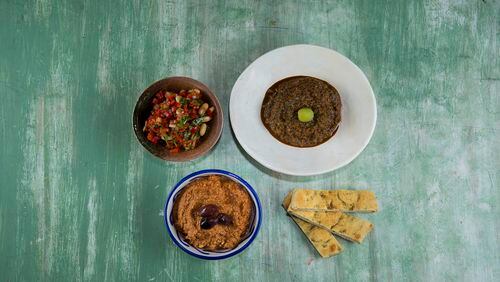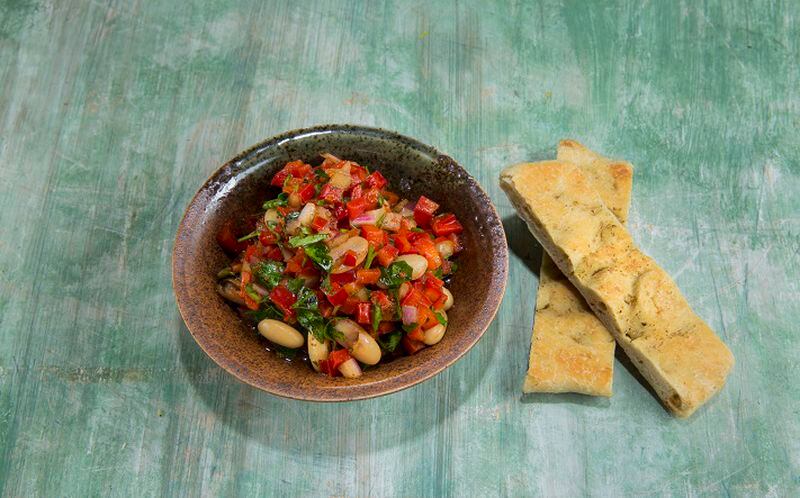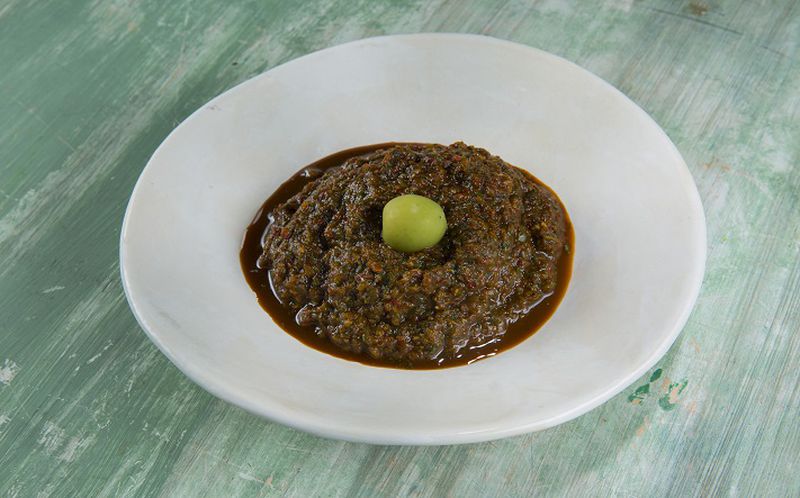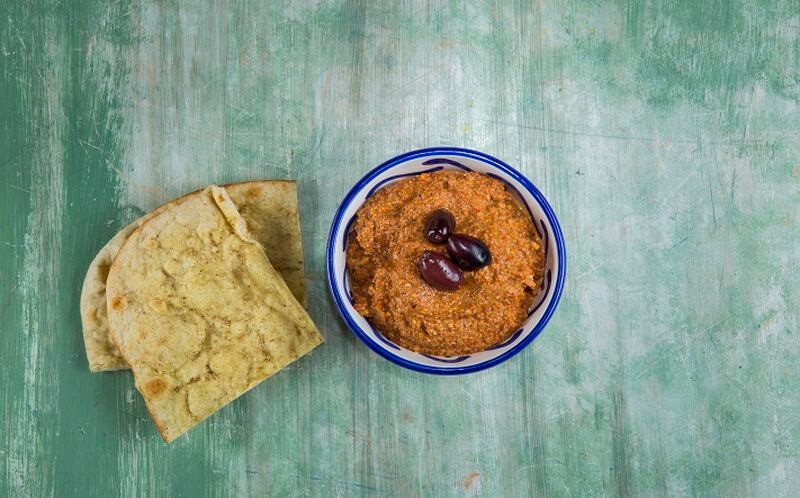When you browse the menu at Niroj Kurdish Cuisine in Agoura Hills, Calif., you’ll probably be tempted to order the cold mezze platter. It’s a colorful display of five dips served alongside a basket of warm homemade bread.
“Two of the dips, the hummus and baba ghanoush, are very Middle Eastern but I would not claim them as Kurdish,” says Nîroj chef-owner Luqman Barwari. But the other three — hesandin dip, piyas and Riha ezme — are specific to Kurdish cuisine. “They are like recipes back home, but with my twist,” Barwari says.
Hesandin means “stuffed,” and the dip is similar to muhammara, containing a blend of roasted red peppers pureed with fresh carrots and walnuts, and flavored with notes of garlic, pomegranate molasses and a touch of Aleppo pepper. Piyas, meaning “onions,” is a vibrant sort of salad, a diced blend of colorful fresh bell peppers, red onions and parsley, brightened with a squeeze of fresh lemon and lightly sweetened with pomegranate molasses. Riha ezme is named after the city of Riha, which is known as Urfa in Turkish. The dip, a puree of roasted peppers with a variety of fresh herbs, also has a hint of spice from pepper paste and ground Aleppo pepper. “Riha is where Aleppo pepper comes from, and I use the pepper a lot in my cuisine.”
Barwari, who has lived most of his life in the United States, is a former scientist but switched gears a few years ago to follow his other passion: cooking. “Being in America for so long, I realized how much we were lacking in good Kurdish food; no one really claims our cuisine here.”
Nîroj celebrated its fourth anniversary in February. The restaurant’s name is a take on “Newroz,” which means “new day” in Kurdish; the holiday, celebrated in a number of countries throughout the Middle East, commemorates the arrival of spring. “Each nation celebrates Newroz a little differently,”says Barwari. “The Kurds generally go out from the cities and villages to the mountains to picnic.
“The Kurds lived in Mesopotamia for thousands of years,” says Barwari. The area is mountainous, and the cuisine relies heavily on the plants and vegetables, herbs and spices collected locally. For Barwari, “Kurdish food is not very spicy, but it is the most flavorful, in my opinion, in the Middle East.” At Nîroj, Barwari has developed close relationships with many of the farmers at the nearby farmers markets, centering his dishes around the local produce.
Riha ezme especially highlights the fresh herbs the chef finds at the markets, and he loves to eat it not just as an appetizer but also with his rice and as part of a wrap. “It’s not on the menu, but I make my own lavash, and I add the sauce, along with kebabs and vegetables and onions.” Sounds like perfect picnic food. “Yes,” he says, laughing. “It is.”
———
Credit: Jay L. Clendenin
Credit: Jay L. Clendenin
PIYAS
Total time: 30 minutes | Makes about 2 quarts
Note: Adapted from a recipe by Luqman Barwari, owner and chef of Nîroj Kurdish Cuisine in Agoura Hills. Pomegranate molasses and Aleppo pepper are generally available at Middle Eastern markets and well-stocked supermarkets, as well as online.
3 red bell peppers, seeded and chopped
3 green bell peppers, seeded and chopped
1 bunch parsley, leaves chopped
1 small red onion, chopped
1 (15 1/2-ounce) can white northern beans, rinsed and drained
2 tablespoons Aleppo pepper, or to taste
1/3 cup extra-virgin olive oil
1/3 cup pomegranate molasses
1 tablespoon sea salt
Juice of 1/2 lemon, more to taste
1. In a bowl, mix together the bell peppers, parsley and onion. Stir in the beans, Aleppo pepper, oil, molasses, sea salt and lemon. Taste, and adjust the seasoning and flavorings if desired. This makes about 2 quarts piyas, which will keep, covered and refrigerated, up to 5 days.
Each 2 tablespoons: 21 calories, 0 g protein, 2 g carbohydrates, 1 g fiber, 1 g fat, 0 g saturated fat, 0 mg cholesterol, 1 g sugar, 114 mg sodium
Credit: Jay L. Clendenin
Credit: Jay L. Clendenin
RIHA EZME
Total time: 35 minutes | Makes about 1 quart
Note: Adapted from a recipe by Luqman Barwari, owner and chef of Nîroj Kurdish Cuisine in Agoura Hills. Pepper paste, pomegranate molasses and Aleppo pepper are generally available at Middle Eastern markets and well-stocked supermarkets, as well as online.
6 to 8 bell peppers, assorted colors
Leaves from 1 bunch basil
Leaves from 1 bunch oregano
Leaves from 1/4 bunch sage
Leaves from 1 bunch Italian parsley
1 tablespoon mild red pepper paste, or to taste
2 tablespoons hot red pepper paste, or to taste
1 clove garlic
1/2 cup (about 1/4) chopped red onion
1/3 cup pomegranate molasses
1 tablespoon Aleppo pepper
Salt, if desired
1. Roast the peppers: Place the peppers on a rack set over a gas stove-top burner at high heat. Roast, turning frequently, until the skin on all sides of each pepper is charred, about 5 minutes. (If you have an electric or ceramic stove-top, roast the peppers in the oven using the broiler setting until charred on all sides.) Wrap each pepper in plastic wrap and set aside until cool enough to handle, then peel the skin (the skin should stick to the plastic wrap). Rub the plastic wrap against the skin to loosen and remove it. Do not rinse the peppers to remove the skin, as rinsing will remove flavor. Stem and seed each pepper.
2. Place the peppers, basil, oregano, sage and parsley in the bowl of a food processor, along with the pepper paste, garlic, onion, molasses and pepper. Puree until smooth. Taste and adjust the flavorings or seasoning if desired. This makes about 1 quart dip, which will keep, covered and refrigerated, up to 5 days.
Each 2 tablespoons: 18 calories, 0 g protein, 4 g carbohydrates, 1 g fiber, 0 g fat, 0 mg cholesterol, 2 g sugar, 81 mg sodium
Credit: Jay L. Clendenin
Credit: Jay L. Clendenin
HESANDIN DIP
Total time: 35 minutes | Makes about 1 quart
Note: Adapted from a recipe by Luqman Barwari, owner and chef of Nîroj Kurdish Cuisine in Agoura Hills. Pomegranate molasses and Aleppo pepper are generally available at Middle Eastern markets and well-stocked supermarkets, as well as online.
4 to 6 red bell peppers
6 carrots, peeled and coarsely chopped
9 ounces (about 2 1/4 cups) walnuts
1 clove garlic, finely grated
3 tablespoons pomegranate molasses, or to taste
1/2 cup extra-virgin olive oil
1 tablespoon salt, or to taste
1 tablespoon Aleppo pepper, or to taste
1. Roast the peppers: Place the peppers on a rack set over a gas stove-top burner at high heat. Roast, turning frequently, until the skin on all sides of each pepper is charred, about 5 minutes. (If you have an electric or ceramic stove-top, roast the peppers in the oven using the broiler setting until charred on all sides.) Wrap each pepper in plastic wrap and set aside until cool enough to handle, then peel the skin (the skin should stick to the plastic wrap). Rub the plastic wrap against the skin to loosen and remove it. Do not rinse the peppers to remove the skin, as rinsing will remove flavor. Stem and seed each pepper.
2. Place the peppers, along with the carrots and walnuts, in the bowl of a food processor and pulse until the mixture is finely chopped.
3. Place the pepper mixture into a bowl, and stir in the garlic, molasses, oil, salt and Aleppo pepper. Taste and adjust the seasoning and flavorings if desired. This makes about 1 quart dip, which will keep, covered and refrigerated, up to 5 days.
Each 2 tablespoons: 97 calories, 2 g protein, 4 g carbohydrates, 1 g fiber, 9 g fat, 1 g saturated fat, 0 mg cholesterol, 2 g sugar, 227 mg sodium
About the Author









